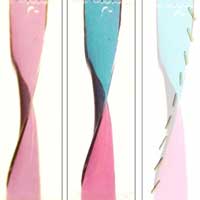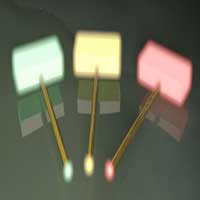 A new film made of gold nanoparticles changes color in response to any type of movement. Its unprecedented qualities could allow robots to mimic chameleons and octopi - among other futuristic applications.
A new film made of gold nanoparticles changes color in response to any type of movement. Its unprecedented qualities could allow robots to mimic chameleons and octopi - among other futuristic applications.
Tuesday, June 16, 2020
Nanomaterial gives robots chameleon skin
 A new film made of gold nanoparticles changes color in response to any type of movement. Its unprecedented qualities could allow robots to mimic chameleons and octopi - among other futuristic applications.
A new film made of gold nanoparticles changes color in response to any type of movement. Its unprecedented qualities could allow robots to mimic chameleons and octopi - among other futuristic applications.
Scientists grow optical chips in a petri dish
 Researchers propose a quick and affordable method to create optical chips right in a Petri dish.
Researchers propose a quick and affordable method to create optical chips right in a Petri dish.
Determining effective magnetic moment of multicore nanoparticles
 New research compares the effective magnetic moments of different multicore nanoparticle systems and shows that they are magnetic-field dependent.
New research compares the effective magnetic moments of different multicore nanoparticle systems and shows that they are magnetic-field dependent.
Researchers light cells using nanosheets for cancer treatment
 Scientists are developing new ways to advance the field of regenerative medicine and cancer treatment with a 2D nanosheet that is 1,000 times smaller than a strand of hair.
Scientists are developing new ways to advance the field of regenerative medicine and cancer treatment with a 2D nanosheet that is 1,000 times smaller than a strand of hair.
Beetle that can survive in volcanic areas inspires new cooling materials
 A type of beetle capable of regulating its body temperature in some of the hottest places on Earth is the centerpiece of new research with major potential implications for cooling everything from buildings to electronic devices in an environmentally friendly manner.
A type of beetle capable of regulating its body temperature in some of the hottest places on Earth is the centerpiece of new research with major potential implications for cooling everything from buildings to electronic devices in an environmentally friendly manner.
Borrowing from robotics, scientists automate mapping of quantum systems
 Scientists have taken an algorithm used for autonomous vehicles and adapted it to help characterise and stabilise quantum technology.
Scientists have taken an algorithm used for autonomous vehicles and adapted it to help characterise and stabilise quantum technology.
Support drives fate of protected gold nanoclusters as catalysts
 Scientists have discovered that the choice of a support material for model catalysts, made from gold nanoclusters protected by organic molecules, may have drastic effects on the structure of the catalyst.
Scientists have discovered that the choice of a support material for model catalysts, made from gold nanoclusters protected by organic molecules, may have drastic effects on the structure of the catalyst.
The smallest motor in the world consists of 16 atoms
 A research team has developed a molecular motor which consists of only 16 atoms and rotates reliably in one direction. It could allow energy harvesting at the atomic level.
A research team has developed a molecular motor which consists of only 16 atoms and rotates reliably in one direction. It could allow energy harvesting at the atomic level.
Subscribe to:
Posts (Atom)
